|
|
Post by sparepart on Jun 2, 2019 1:03:34 GMT
Two major projects underway: The team installed the payphone in the booth, removed the broken florescent lamps, and cleaned the glass. We also test fit the first rack, mixer and microphone boom for the engineers desk. So why does the engineers desk need a microphone? In case you are working by yourself in the studio!
View from the Engineers station
Drilling out broken screws to fix the lights in the phone booth!
|
|
|
|
Post by sparepart on Jun 11, 2019 1:13:03 GMT
Screen grab from the security camera. One more 4 x 8 foot reflection damper to go....
The view in the opposite direction (and yes, the phone booth works!)
|
|
|
|
Post by sparepart on Jun 23, 2019 11:32:21 GMT
Since we did not have the bucket truck to mount the antenna on the pole, we worked on minor projects in the studio - Drilled the cable access holes in the tabletop for the engineers workstation. We still need to connect the holes with a heavy-duty sabre or jig saw.
- Cut the table stiffeners to length so the workstation countertop does not sag. Part number is Regency MTS46 if you happen to need one!
- Installed the cable anchors for the audio cabling on the wall between the engineers workstation and the podcast table. These are slotted cable cleats that accept a Velcro strap.
- Updated the firmware on the Telos Two x 12 broadcast phone system. This is a scaled-up version of the speakerphone on the table, it's ready to deploy once the racks are moved into place.
- We updated the mounting system for the monitors on the engineers workstation and mounted a pair of HP monitors, along with finishing the mounting for the mike boom.
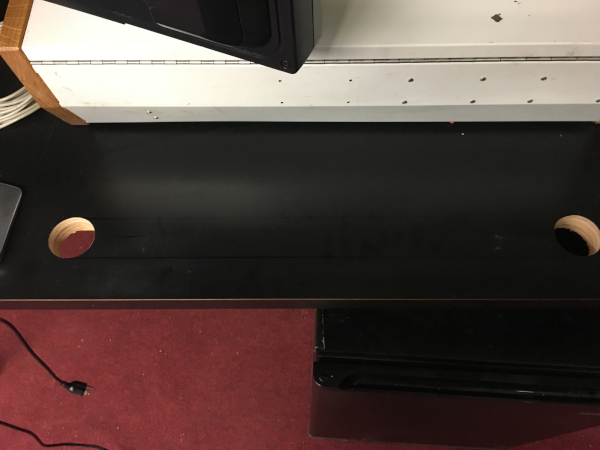 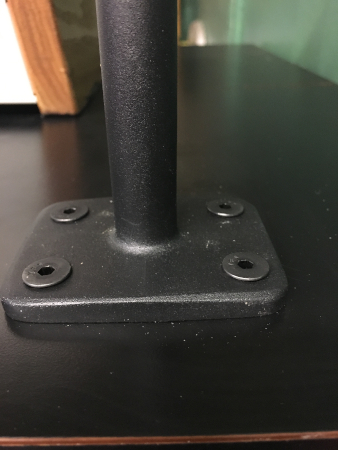 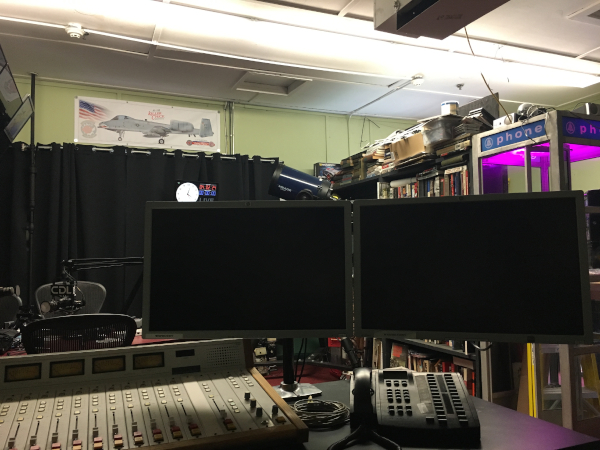 SP |
|
|
|
Post by sparepart on Aug 18, 2019 0:33:07 GMT
While we are waiting for our volunteer with the bucket truck to install the antenna, the usual suspects integrated a mix of new, old, and recycled parts into the new Tech Rack. Another minor (but important) project: We deployed a shock mount for the engineers microphone on the boom. Next trip we will cable it and deploy the microphone.
SP
|
|
|
|
Post by sparepart on Sept 7, 2019 14:36:15 GMT
Screen grab from the Security camera. Last shot before dismantling the road case with the audio chain (moving the gear to the Tech rack)
Next step is adding a third reflection control panel to the wall, and another set of mask curtains on the left
|
|
|
|
Post by Boomer on Sept 10, 2019 18:02:36 GMT
Lots of stuff, and your students will be able to learn nicely there, they'll be dazzled by the high tech and want to come back for more.
|
|
|
|
Post by sparepart on Sept 10, 2019 23:12:32 GMT
Saturday we had a bunch of students stop by to visit. Monday night we had a couple veterans stop by - was great hearing history from the people that were there, and not what ended up in the books.
*this* is why our volunteers step up....
|
|
|
|
Post by sparepart on Oct 6, 2019 18:15:10 GMT
Quick Hardware update: I had mentioned CDL was using a BSD licensed product called OAS (On Air Screen) in the CDL Studio, with a slave displays planned at the engineers workstation, and in the Makerspace workshop . Link: github.com/saschaludwig/OnAirScreen
OAS has been set up on an Raspberry PI, with the PoE shield on the back of the monitor. OAS loads itself full-screen, no keyboard or mouse needed.
We are working on a supportable means to turn the various "lights" on the display(s) on and off automatically over the network using UDP messages.
As an example: The Wheatstone R60 console has a relay that activates when any of mixer channels are active and feeding the main output. The relay contacts will drive a logic (GPIO) pin on a single-board computer (Xunlong Orange Pi Zero). The Pi Zero is running a python application that will generate a UDP message on the network to activate the "on-air" light on each display. The phone, doorbell, and UPS / HVAC alarm would work in a similar fashion.
SP
|
|
|
|
Post by sparepart on Nov 10, 2019 13:57:20 GMT
The crew spent Saturday at the CDL Makerspace. Our building was host to the Vintage Computer Federation's antique system repair workshop, so it was a full house. Link to VCF: vcfed.org/wp/Migrated 95% of the audio chain to the new tech rack, next steps are the permanent interconnections between the dBX 286 processors and the Wheatstone R-60. 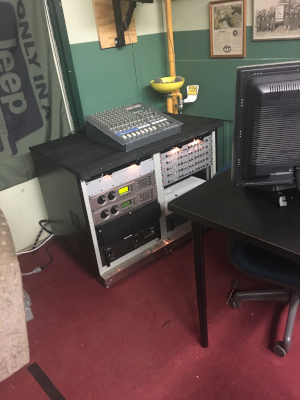 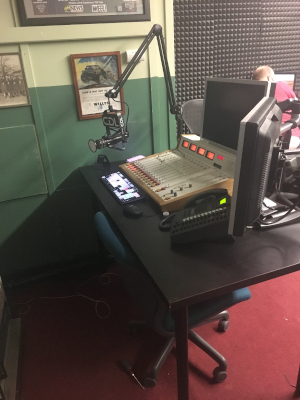 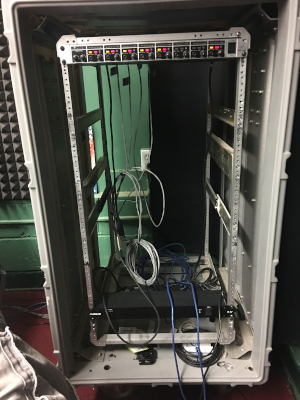 |
|
|
|
Post by sparepart on Dec 3, 2019 3:12:57 GMT
Ready to go on the air:
Photo: Mark Viteo
|
|
|
|
Post by sparepart on Jan 15, 2020 1:55:10 GMT
One of our success stories!
Our podcast host Dan J resurrected a donated Vizio P602UI television by swapping out the power supply board and re-seating cables. Plan is to put it in the Makerspace office for the security system
We discovered the original power supply module had a design issue. The follow-on board design is not prone to the same failure mode.
|
|
|
|
Post by Boomer on Jan 18, 2020 10:30:29 GMT
Right now I've been working on a Vizio 37" inch TV, from 2006, and bought a new main board for it, the old one was felled by a leaking capacitor, probably a 'plague cap'. The juice went inside of some via holes on the board and corroded traces inside of the board, and caused shorts apparently. The TV still has issues, but I'm trying to work them out.
Compared to new TVs that have almost nothing inside, and few external jacks, the Vizio has the complete compliment of in and out jacks available at the time, and it's a rock solid TV structurally.
Boomer
|
|
|
|
Post by sparepart on Jan 19, 2020 19:05:45 GMT
Compared to new TVs that have almost nothing inside, and few external jacks, the Vizio has the complete compliment of in and out jacks available at the time, and it's a rock solid TV structurally. Seeing the same on the Vizio P602UI television we are working on.
SP
|
|
|
|
Post by sparepart on Jan 19, 2020 19:12:44 GMT
Wrapped up the upgrades to our JetLink client appliance. It's running W10 pro on a repurposed 1U Supermicro system. This is basically a PC in a 1U rack mount case - Intel Atom D525 processor, with 4GB of DDR3 800MHz memory and a 500GB SSD. JetLink is really interesting as you can have as many senders as you want (such as the above PC) and only license the receiver. Info: jetlink.co/
SP
|
|
|
|
Post by Boomer on Jan 20, 2020 1:32:29 GMT
We may be past the golden age of flat screen TV, pictures look good, but they're cheap, and cheap they lack jacks.
That rack mount server looks nice, and Atom boards can do a lot of things and keep the power down. My soon-to-be auto_dj computer for my station has an Atom processor in it, in an old case with a few TB drive, and the audio is being organized right now.
What I'm looking for in audio over IP is a way to have another host on the air for several hours from another city and get away from Skype hell. We tried a few others, browser based chat with longer latency, and SIP phone Ekiga on Linux that had a less than broadcast quality codec, narrow voice quality. At the end of its run, Skype for Linux worked so well and the sound quality had gone up to near broadcast, it was stable, and then they had to discontinue what we'd been using!
We tried Feen Phone, which uses Opus at adjustable bit rates, it seemed promising, but we couldn't get past the frustration, and Feen is not developing it now. The sound was so good too, Opus at 32k would be good enough.
We're looking for a free or even cheap software (this is Part-15 after all) to provide a solid, quality audio connection so the regular remote host could be heard through a laptop into a mixer board, and be able to hear back what's going on in the studio, and for it to be quality sound and low latency.
Boomer
|
|